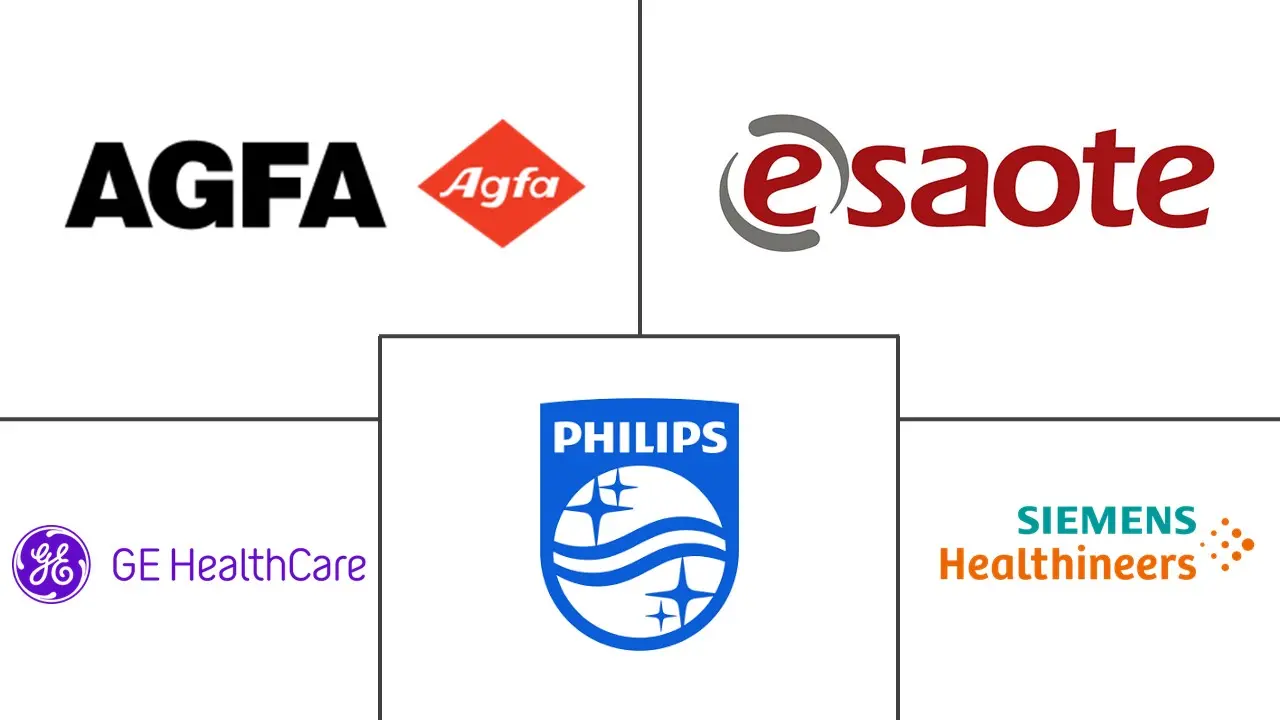Ultrasound Image Analysis Software Market Size and Share
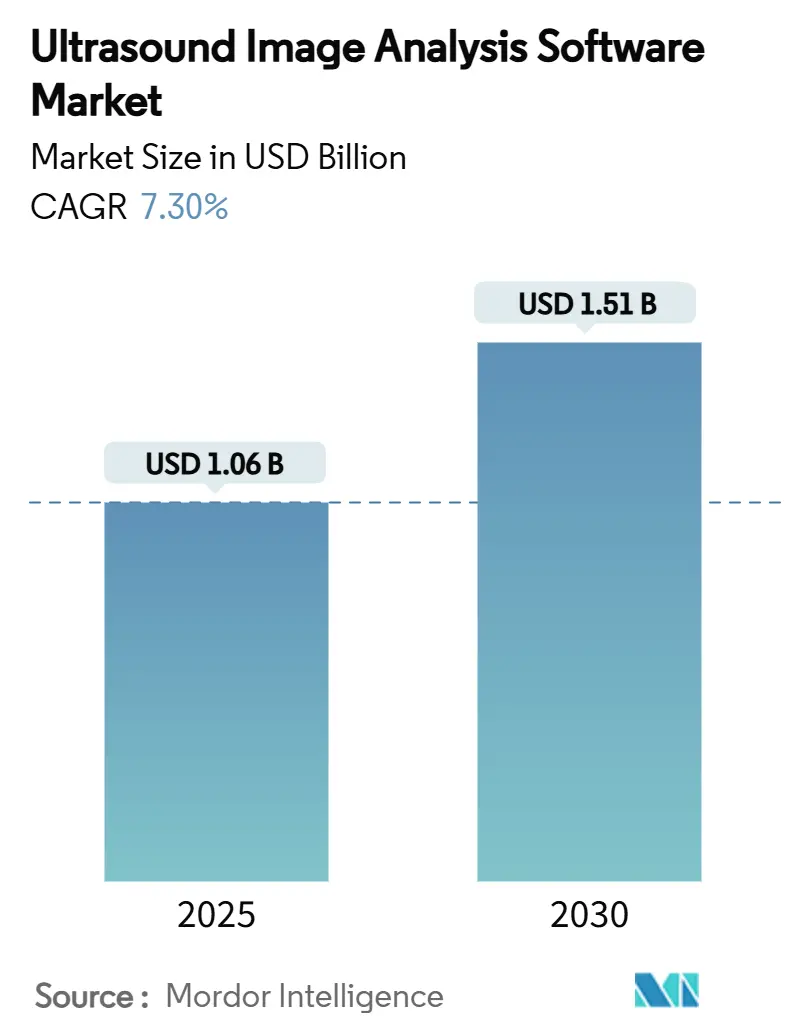
Ultrasound Image Analysis Software Market Analysis by Mordor Intelligence
The ultrasound image analysis software market stood at USD 1.06 billion in 2025 and is forecast to reach USD 1.51 billion by 2030, expanding at a 7.30% CAGR. This outlook positions the ultrasound image analysis software market as a vital digital health segment, benefiting from AI-driven automation that shortens reading times, boosts diagnostic confidence, and alleviates workforce shortages. Integrated AI modules that automate routine measurements, standardize reporting, and flag anomalies in real time are migrating from research pilots into everyday clinical practice. Point-of-care ultrasound (POCUS) and handheld devices, which grew sharply during pandemic-era bedside care protocols, now anchor the next growth wave. Hospitals demand software that plugs seamlessly into PACS/HIS stacks to unlock cross-departmental image exchange, while oncology, cardiology, and maternal-fetal medicine rely on advanced radiomics to personalize therapy selection. Cost pressures and an aging sonographer cohort continue to accelerate adoption of autonomous scanning and cloud-native collaboration tools, securing a solid long-term runway for the ultrasound image analysis software market.
Key Report Takeaways
- By software type, integrated solutions commanded 60.51% of ultrasound image analysis software market share in 2024; standalone software is projected to post a 9.25% CAGR to 2030.
- By product, 3D/4D systems captured 38.53% of the ultrasound image analysis software market size in 2024, while Doppler technology is forecast to expand at 10.85% CAGR to 2030.
- By clinical application, obstetrics and gynecology led with 26.63% ultrasound image analysis software market share in 2024; oncology applications will advance at 10.87% CAGR through 2030.
- By end user, hospitals and ambulatory surgery centers held 48.63% of the ultrasound image analysis software market size in 2024, whereas diagnostic imaging centers are set for 9.14% CAGR growth through 2030.
- By geography, North America contributed 41.32% revenue in 2024, yet Asia-Pacific is projected to see the fastest 9.27% CAGR to 2030.
Global Ultrasound Image Analysis Software Market Trends and Insights
Drivers Impact Analysis
| Driver | (~) % Impact on CAGR Forecast | Geographic Relevance | Impact Timeline |
|---|---|---|---|
| Increasing burden of chronic diseases | +1.8% | Global – most pronounced in North America & Europe | Long term (≥ 4 years) |
| Rapid AI + ML innovation in ultrasound | +2.1% | Global – led by North America & Asia-Pacific | Medium term (2-4 years) |
| Surging demand for point-of-care/handheld | +1.5% | Global – strongest in Asia-Pacific & MEA | Short term (≤ 2 years) |
| Hospital workflow digitalisation mandates | +1.2% | North America & EU, expanding in Asia-Pacific | Medium term (2-4 years) |
| Cloud-native tele-sonography platforms | +0.9% | Early adoption in developed markets | Medium term (2-4 years) |
| Ultrasound radiomics uptake in oncology | +0.7% | North America & EU, emerging in Asia-Pacific | Long term (≥ 4 years) |
| Source: Mordor Intelligence | |||
Increasing Burden Of Chronic Diseases
Escalating cardiovascular, diabetic, and oncologic caseloads are driving a 7% annual increase in ultrasound studies, especially in obstetric and gastroenterology clinics. Insufficient radiologist hours and limited sonographer supply intensify the need for automated post-processing that triages abnormal exams and reduces repeat scanning. Point-of-care ultrasound outperforms chest X-ray in pneumonia detection and lowers episode-of-care costs, validating software investment for value-based care providers. Emerging economies view ultrasound as the most affordable imaging entry point, so vendors that optimize algorithms for mid-tier hardware and intermittent connectivity unlock sizable addressable demand.
Rapid AI + ML Innovation In Ultrasound Analytics
Deep-learning pipelines now deliver real-time speckle reduction, automated biometry, and probability-based lesion categorization that guide novice operators. FDA clearances for Caption Guidance and similar tools indicate regulatory openness to AI ultrasound, yet only 59 of 950 cleared AI devices target sonography, highlighting scope for new submissions. Radiomics models built from head-and-neck ultrasound achieve >90% treatment-response prediction accuracy, illustrating clinical gains beyond workflow acceleration. Partnerships, such as GE HealthCare and NVIDIA, leverage parallel computing to pursue autonomous scanning, aiming to shift reliance from scarce human expertise to software.
Surging Demand For Point-Of-Care / Handheld Ultrasound
Smartphone-tethered probes and tablet-based consoles shrink acquisition costs and bring imaging to primary-care clinics, home visits, and austere settings. Pandemic protocols validated bedside lung and vascular scans, entrenching POCUS in standard triage. Comparative studies report image quality parity between six leading handheld devices and traditional systems for core abdominal views. AI guidance overlays that coach users on probe positioning lower training barriers and feed more consistent datasets for back-end analytics, sustaining momentum of the ultrasound image analysis software market.
Hospital Workflow Digitalisation & Data-Interoperability Mandates
Policy and payer quality programs reward closed-loop reporting and image exchange, prompting hospitals to phase out siloed carts. Implementations of AI-enabled workflow suites have cut documentation time by 45% and saved USD 428 per encounter[1]Kristin Pingili, “How Workflow Optimization Improves Patient Care,” International Journal of Research in Computer Applications and Information Technology, iaeme.com. Full DICOM-IHE compliance is now table stakes; however, legacy PACS environments complicate rollouts, reinforcing demand for vendor support and open APIs.
Restraints Impact Analysis
| Restraint | (~) % Impact on CAGR Forecast | Geographic Relevance | Impact Timeline |
|---|---|---|---|
| Shortage of trained sonographers & high price | -1.4% | Global – most acute in North America & EU | Short term (≤ 2 years) |
| Interoperability gaps with legacy PACS/HIS | -0.8% | North America & EU, emerging in Asia-Pacific | Medium term (2-4 years) |
| AI bias & regulatory scrutiny on ethnic variance | -0.6% | Global – strictest in North America & EU | Long term (≥ 4 years) |
| Cyber-security risks in connected endpoints | -0.5% | Highest in developed markets | Medium term (2-4 years) |
| Source: Mordor Intelligence | |||
Shortage Of Trained Sonographers & High Software Price
Sonographer retirements average age 60.8, four years earlier than national averages, while 90% report musculoskeletal disorders from repetitive scanning[2]Jim Baun, “Early Retirement in the Sonography Community: What’s Next?” Journal of Diagnostic Medical Sonography, journals.sagepub.com. Vacancies force overtime and reduce mentoring capacity, constraining new graduate pipelines. AI modules that automate acquisitions can ease workloads but often carry premium license fees beyond small-clinic budgets, limiting uptake where staff shortfalls are most pronounced.
Interoperability Gaps With Legacy PACS/HIS
Hospitals still running ACR-NEMA-era archives face 4- to 12-month integration projects, delaying software benefits. Color-flow mis-registrations and metadata corruption degrade Doppler reads, demanding middleware and IT resourcing that many community sites lack.
Segment Analysis
By Software Type: Integrated Solutions Drive Market Consolidation
Integrated platforms generated 60.51% ultrasound image analysis software market share in 2024 as providers sought a single pane for acquisition, review, and archival. Bundled ecosystems cut training time and capitalize on existing hardware footprints, giving conglomerates like Philips and Siemens Healthineers cross-selling leverage. Standalone suites, though smaller, will outpace at 9.25% CAGR by 2030, propelled by niche AI analytics that plug into multi-vendor fleets. Oncology radiomics start-ups illustrate this tailwind, offering cloud APIs that overlay legacy scanners without forklift upgrades, positioning the ultrasound image analysis software market for a hybrid growth architecture.
Integrated dominance mirrors hospital sourcing that bundles service contracts and cybersecurity certifications into multi-year deals. Yet radiology groups and outpatient centers prize vendor-neutral engines that shield them from lock-in and enable rapid algorithm swaps. As reimbursement shifts toward value-based care, demand rises for outcome-tracking dashboards that aggregate longitudinal imaging data, an edge currently delivered faster by agile standalone vendors.
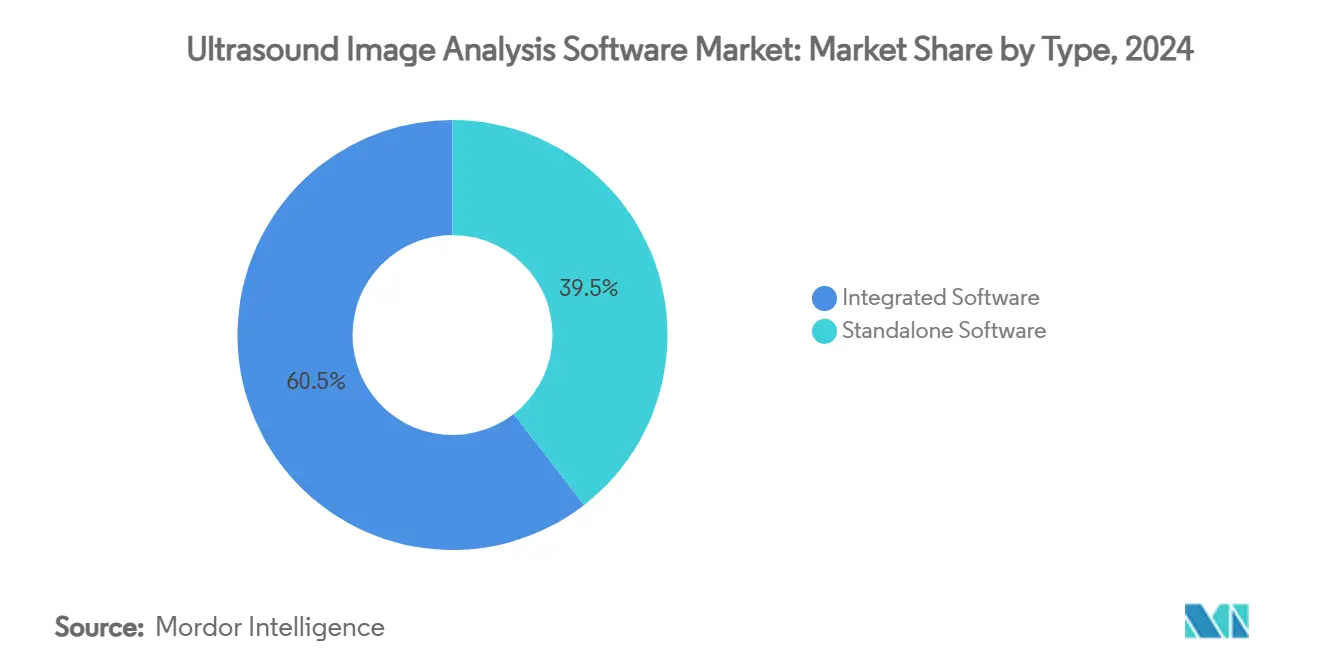
By Product: 3D/4D Technology Leads While Doppler Shows Strongest Growth
The 3D/4D category captured 38.53% of ultrasound image analysis software market size in 2024 thanks to volumetric fetal, cardiac, and oncologic imaging. Real-time rendering boosts patient engagement and improves anatomical delineation for surgical planning. Doppler variants, set to rise at 10.85% CAGR, ride global cardiovascular screening programs and AI flow-quantification that lifts sensitivity for stenosis detection.
AI-super-resolution algorithms now reconstruct clearer hemodynamic maps from standard Doppler data, extending utility to resource-limited clinics lacking high-end probes. Meanwhile, iterative deep-learning noise suppression revitalizes 2D platform sales, underscoring that incremental software advances can reinvigorate mature hardware lines.
By Clinical Application: Obstetrics Leadership Faces Oncology Challenge
Obstetrics held 26.63% ultrasound image analysis software market share in 2024 driven by mandated prenatal scans and AI-enabled anomaly screening. Automated measurement suites trim exam time and ensure guideline adherence, critical amid sonographer scarcity. Oncology, predicted at 10.87% CAGR, benefits from radiomics that stratify breast and liver tumors by histology, aiding therapy planning without invasive biopsy.
Cardiology software gains from AI echocardiography tools that quantify ejection fraction and wall-motion scores, while nephrology modules monitor chronic kidney disease progression. Specialty-centric algorithm libraries open premium SaaS revenue layers beyond base licenses, further diversifying the ultrasound image analysis software market.
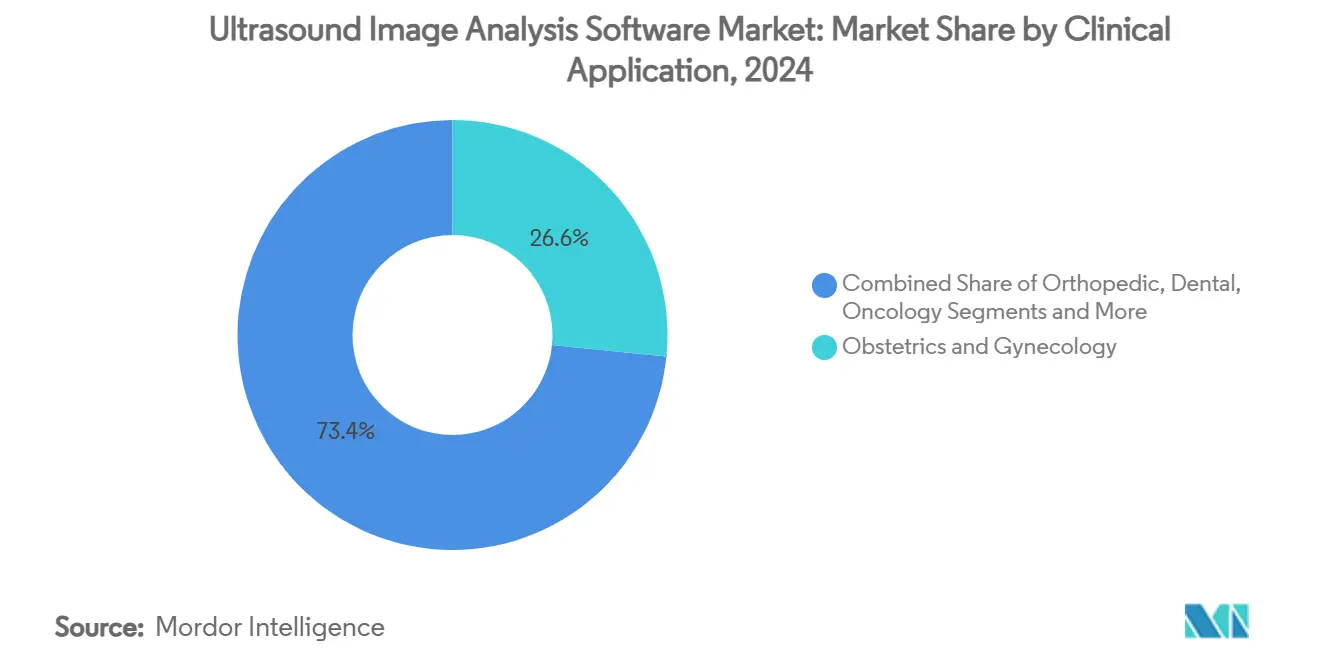
Note: Segment shares of all individual segments available upon report purchase
By End User: Hospital Dominance Challenged by Diagnostic Centers
Hospitals and ASCs contributed 48.63% of ultrasound image analysis software market size in 2024 owing to multi-disciplinary imaging demand and bundled EMR purchases. Yet regulatory cost pressure and outpatient migration propel imaging-center uptake at 9.14% CAGR. Independent centers deploy cloud PACS and AI triage to manage throughput with lean staff, positioning themselves as rapid-turnaround partners for accountable-care networks.
Academic institutes, while smaller in revenue, shape product roadmaps through early-phase validation of AI decision support and tele-mentoring frameworks. Their datasets reinforce FDA submissions and offer vendors critical feedback loops for algorithm bias mitigation.
Geography Analysis
North America retained 41.32% revenue leadership in 2024, underpinned by robust reimbursement policies and early adoption of AI-enabled imaging. Integrated software upgrades align with government initiatives that incentivize interoperable EHRs, creating fertile ground for the ultrasound image analysis software market. Workforce shortages—more than 1,400 open radiology posts—heighten reliance on automated measurement and reporting to maintain service levels[3]American College of Radiology, “How Will We Solve Our Radiology Workforce Shortage?” acr.org. The region also pioneers cybersecurity governance, with new FDA mandates that extend Secure-Development-Lifecycle requirements to medical AI.
Asia-Pacific is forecast at 9.27% CAGR through 2030, reflecting hospital infrastructure build-outs and government policies that favor local manufacturing. China’s 85% local-content rules spur domestic software houses to embed AI within cost-optimized ultrasound consoles, accelerating technology diffusion. Southeast Asia’s USD 6.3 billion digital-health fund-raising underscores investor appetite for tele-imaging and cloud PACS start-ups, powering the ultrasound image analysis software market toward wider rural penetration.
Europe exhibits steady adoption shaped by GDPR-aligned data-sharing frameworks and cross-border research consortia that validate AI radiomics. Emerging economies in Africa and Latin America remain nascent but promising, with eHealth pilots showing potential 15% efficiency gains through tele-ultrasound triage and cloud archives. Success hinges on mobile-first designs that tolerate intermittent bandwidth and deliver low-power edge inference.
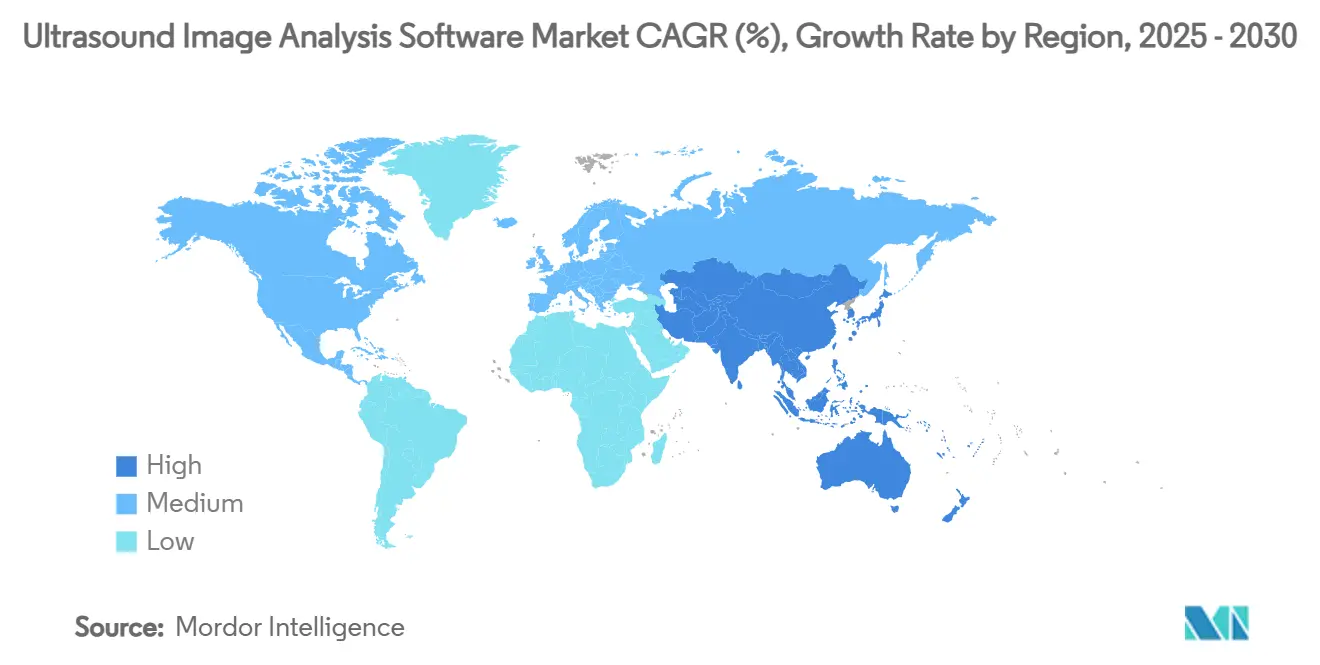
Competitive Landscape
Competition remains moderately fragmented as legacy equipment giants contend with agile AI vendors. GE HealthCare acquired Intelligent Ultrasound's clinical AI arm for USD 53 million, fortifying its installed base and enriching breast and vascular analytics modules. Samsung spent USD 92 million on fetal AI specialist Sonio, signaling a strategic pivot toward software-centric differentiation.
Start-ups target white-space niches, with Us2.ai and Fujifilm collaborating on automated echo quantification, and UltraSight and Mayo Clinic developing AI for novice-led cardiac POCUS. RadNet's 2025 acquisition of See-Mode Technologies expands screening algorithms for thyroid nodules and underscores diagnostic-center influence on product roadmaps.
Cyber-security and fairness oversight intensify competitive stakes. Vendors invest in diverse training cohorts and secure software bill-of-materials disclosures to comply with evolving rules, while patent filings for deep-learning reconstruction and autonomous scanning continue to climb. Market success increasingly hinges on demonstrating clinically validated AI that integrates into heterogeneous hospital IT ecosystems without locking buyers into proprietary silos.
Ultrasound Image Analysis Software Industry Leaders
-
Koninklijke Philips N.V.
-
Esaote SpA
-
GE Healthcare
-
Siemens Healthcare
-
Agfa Healthcare
- *Disclaimer: Major Players sorted in no particular order

Recent Industry Developments
- June 2025: RadNet acquired See-Mode Technologies to enhance AI ultrasound screening for thyroid cancer.
- March 2025: GE HealthCare launched Invenia ABUS Premium, a 3D breast ultrasound with Verisound AI assistant.
Global Ultrasound Image Analysis Software Market Report Scope
Image analysis software, also known as image recognition or computer vision, processes images to extract details using artificial intelligence.
The market for ultrasound image analysis software is segmented by software type, product, clinical application, end user, and geography. By software type, the market is segmented into integrated software and standalone software. By product, the market is segmented into 2D ultrasound, 3D/4D ultrasound, and Doppler ultrasound. The clinical application segment is further segmented into orthopedic, dental, oncology, obstetrics and gynecology, nephrology and urology, radiology, and cardiology. By end user, the market is segmented into hospitals and ASCs, diagnostic imaging centers, and research and academic institutes. The geography segment is further segmented into North America, Europe, Asia-Pacific, the Middle East and Africa, and South America. The report also covers the estimated market sizes and trends for 17 countries across major global regions. The report provides the value (in USD) for all the above segments.
| Integrated Software |
| Standalone Software |
| 2D Ultrasound |
| 3D / 4D Ultrasound |
| Doppler Ultrasound |
| Orthopedic |
| Dental |
| Oncology |
| Obstetrics & Gynecology |
| Nephrology & Urology |
| Radiology |
| Cardiology |
| Hospitals & ASCs |
| Diagnostic Imaging Centers |
| Research & Academic Institutes |
| North America | United States |
| Canada | |
| Mexico | |
| Europe | Germany |
| United Kingdom | |
| France | |
| Italy | |
| Spain | |
| Rest of Europe | |
| Asia-Pacific | China |
| Japan | |
| India | |
| South Korea | |
| Australia | |
| Rest of Asia-Pacific | |
| Middle East and Africa | GCC |
| South Africa | |
| Rest of Middle East and Africa | |
| South America | Brazil |
| Argentina | |
| Rest of South America |
| By Software Type | Integrated Software | |
| Standalone Software | ||
| By Product | 2D Ultrasound | |
| 3D / 4D Ultrasound | ||
| Doppler Ultrasound | ||
| By Clinical Application | Orthopedic | |
| Dental | ||
| Oncology | ||
| Obstetrics & Gynecology | ||
| Nephrology & Urology | ||
| Radiology | ||
| Cardiology | ||
| By End User | Hospitals & ASCs | |
| Diagnostic Imaging Centers | ||
| Research & Academic Institutes | ||
| Geography | North America | United States |
| Canada | ||
| Mexico | ||
| Europe | Germany | |
| United Kingdom | ||
| France | ||
| Italy | ||
| Spain | ||
| Rest of Europe | ||
| Asia-Pacific | China | |
| Japan | ||
| India | ||
| South Korea | ||
| Australia | ||
| Rest of Asia-Pacific | ||
| Middle East and Africa | GCC | |
| South Africa | ||
| Rest of Middle East and Africa | ||
| South America | Brazil | |
| Argentina | ||
| Rest of South America | ||
Key Questions Answered in the Report
What is the current value of the ultrasound image analysis software market?
The ultrasound image analysis software market stands at USD 1.06 billion in 2025 and is projected to reach USD 1.51 billion by 2030.
Which segment holds the largest ultrasound image analysis software market share?
Integrated software solutions lead with 60.51% share as of 2024, reflecting demand for all-in-one imaging platforms.
Which product is growing fastest within the ultrasound image analysis software market?
Doppler technology is expected to register the highest 10.85% CAGR through 2030, thanks to cardiovascular screening initiatives.
Which region will expand quickest?
Asia-Pacific is forecast to grow at 9.27% CAGR through 2030, supported by healthcare infrastructure investments.
What are key restraints facing the ultrasound image analysis software industry?
A global sonographer shortage, integration challenges with legacy IT systems, and heightened cybersecurity requirements are the main hurdles.
Page last updated on:
